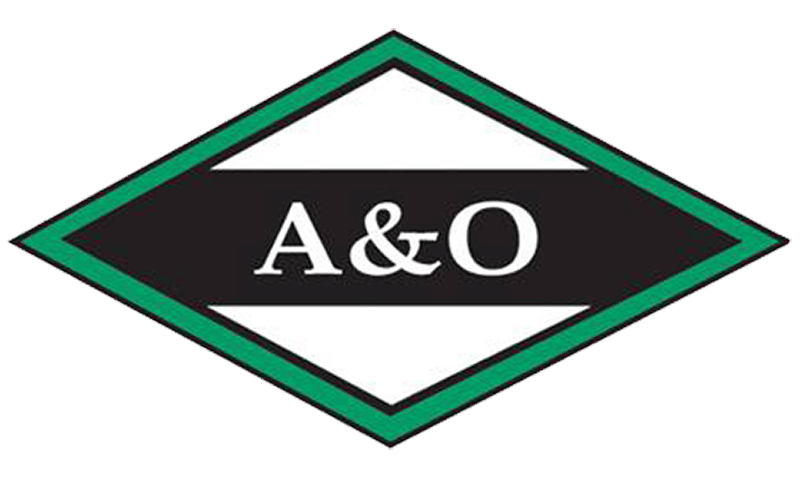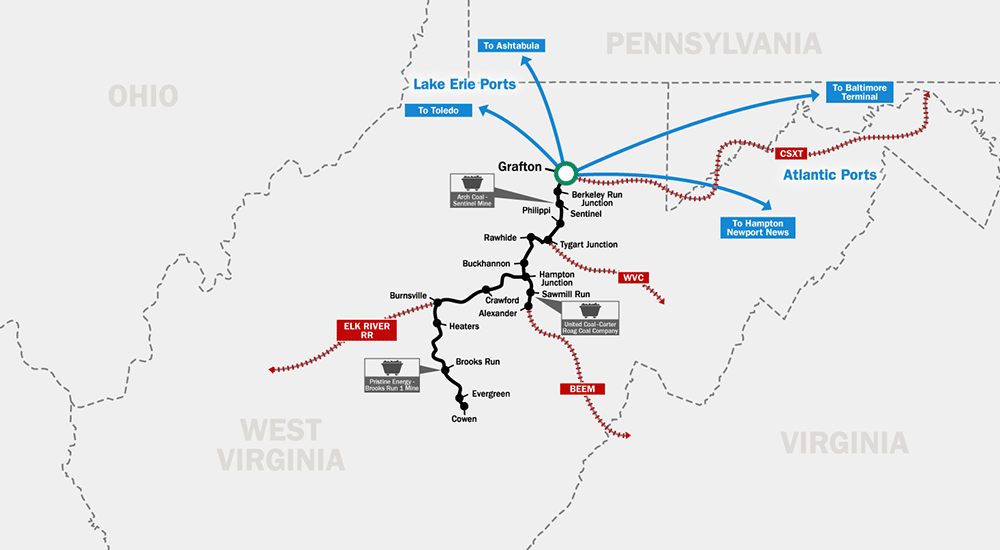OUR COMPANY
ABOUT US
Company Profile
P&L Transportation, Inc., acquired the Appalachian and Ohio Railroad, Inc., or A&O from Watco Transportation Services, Inc. on May 15, 2006. The A&O is a privately held corporation and subsidiary of P&L Transportation, Inc. a Delaware Corporation.
The Appalachian and Ohio operates 158 miles of rail lines, between Grafton and Cowen, WV.
Coal is the primary commodity the A&O transports, from the several coal mines it serves. Other freight includes logs, lumber, and chemicals.
The Appalachian and Ohio interchanges with CSXT at Grafton, WV. It also connects with three short line railroads: BEEM at Alexander, WV; ELKR at Burnsville Junction, WV; and WVC at Tygart Junction, WV.
Transparency in Coverage – Anthem
This link leads to machine-readable files that are made available in response to the federal Transparency in Coverage Rule and includes negotiated service rates and out-of-network allowed amounts between health plans and healthcare providers. The machine-readable files are formatted to allow researchers, regulators, and application developers to more easily access and analyze date.
Current Career Opportunities
Train Crew (Conductors)
Locations
Grafton, WV
Job Summary
Train Crew (Conductors and Engineers)
The primary job of a train crew is to efficiently deliver and pick up loaded and unloaded freight cars from our customers. Train crews also perform a “switching” function of arranging freight cars in a train for delivery to other railroads and breaking down the assembled trains we receive from other railroads prior to delivery to our customers.
Conductors are in charge of the train. They determine what will be done and how it will be done. They also handle all the paperwork and computer work. Engineers operate or “drive” the train. Conductors promote to Engineer based on seniority.
Prior to the start of employment for train service, P&L selects candidates for our local training program. A series of operating rules and safety tests must be passed before promotion to the position of conductor which is approximately 12 weeks. Union pay scale and benefits start immediately upon promotion to conductor.
Since all railroads operate 24/7, new conductors work off an “extra board” and work on an on call basis. The call for work will be a 2 hour notice at any time day or night and are not optional. Conductors can work up to a 12 hour shift. Upon leaving work, conductors will have a mandatory minimum time off of 10 hours after each shift before being subject to call again.
All employees (and trainees) are subject to Federal drug/alcohol testing programs and Federal Safety Rules.
UPDATED 10-1-2025
Careers
A&O Railway accepts online applications and resumes. All applications and resumes are retained on file for one year.
Please state your area of interest (or department) in your cover letter.
By Mail Resumes
Attention: Human Resources
Appalachian & Ohio Railroad, Inc.
200 Clark St.
Paducah, KY 42003
Online
Online Resumes and cover letters may also be submitted by email to: hr@a-orailroad.com
FAQ
How do I contact the Railroad Retirement Board?
Phone: 877-772-5772
Or check out their website at rrb.gov
How can I buy railroad ties?
The A&O does not have railroad ties for sale to the public.
Can I take photographs of trains?
Safety is the prime importance to the A&O. We do not allow anyone other than employees on railroad property without prior, written authorization. All trespassers will be prosecuted!
Can I ride on your trains?
The A&O is a FREIGHT railroad. We do NOT operate a passenger service.
How do I do business with your railroad?
Your “first line” of contact is the A&O Marketing Department. Anyone in that Department will readily assist you. Refer to the Marketing Department’s contact listings under the “Contact Us” section of the website.
My business is not rail-served. How can I take advantage of rail transportation to ship my products or receive raw materials?
There are many industries not directly rail served which can still enjoy the benefits of rail transportation.
Team Tracks (available free of charge to the general public for loading and unloading of product to/from railcars) are located in many cities along the A&O; contact the A&O’s Marketing Department for further details.
Several transloads are served by the A&O; these provide loading/unloading, warehousing, and trucking services between rail car and an industry.
How do I know what it will cost to transport my product by rail?
Before 1981 most rail rates were established through rate bureaus.
Since the Staggers Act of 1981, however, rail carriers have basically had the freedom to price according to the market. Many “public” prices are found on each carrier’s website; these can be utilized for many movements. Confidential rates, however, are in many instances negotiated for competitive, volume movements by contacting the serving railroad’s Marketing Department.
Most rates are based upon (1) the product and volume to be shipped, (2) cost—which roughly corresponds with the distance moved, (3) equipment type, availability, and ownership, and (4) market conditions and competition. Railroad freight rates include the empty return of a rail car to the point of origin.
My company doesn't own rail cars, can I still ship by rail?
Of course. The A&O’s Marketing Department can assist you in determining the type and size of railcar you need and in securing that car for loading. The A&O’s Mechanical Department can be called upon for questions regarding proven and official loading methods and specifics.
What type or rail cars are available? How much can I ship in a rail car?
All rail cars in Mexico, the U.S.A. and Canada are listed in the “Equipment Register” and those operating on U.S. railroads must meet the Association of American Railroads (AAR) and federal government construction standards for safety and interlining (movement between railroads), and must be maintained to those standards.
The common freight cars are: box, flat, covered hopper, open top hopper, tank, and gondola, each costing from $40,000 for a standard railcar ordered in quantity, to over $200,000 for a specialized tank car. Special cars include the heavy duty flat, refrigerated box, pneumatic and pressure differential covered hopper, auto rack flat, 90′ pole flat, 80′ high-cube boxcar. 24′ open top ore hopper, and many others.
All railcars are 9.5 feet wide, give or take 10 inches, and range from 24′ to 90′ in length. Most are 10 to 12 feet high—except for flat cars which are, of course, flat, and gondolas usually have 3′ to 4′ high sides. Car height is measured from the floors of rail cars, which are 3.5′ to 4.5′ above the top of the rail.
Most rail cars’ load capacities range from 120,000 pounds (some boxcars and special cars for lighter commodities) to 200,000 pounds (most newer cars of all types). Some special tank cars and heavy duty flat cars for moving electrical transformers and equipment carry much more tonnage. The load capacity and empty tare weight is stenciled on the side of every railcar. Normal maximum gross weight (total weight of rail car and its contents) is 286,000 pounds.


